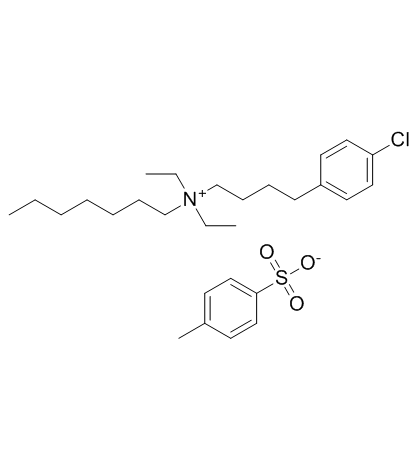Clofilium tosylate

Clofilium tosylate structure
|
Common Name | Clofilium tosylate | ||
|---|---|---|---|---|
| CAS Number | 92953-10-1 | Molecular Weight | 510.172 | |
| Density | N/A | Boiling Point | N/A | |
| Molecular Formula | C28H44ClNO3S | Melting Point | N/A | |
| MSDS | Chinese USA | Flash Point | N/A | |
| Symbol |

GHS07 |
Signal Word | Warning | |
Use of Clofilium tosylateClofilium tosylate, a potassium channel blocker, induces apoptosis of human promyelocytic leukemia (HL-60) cells via Bcl-2-insensitive activation of caspase-3. Antiarrhythmic agent[1]. |
| Name | 4-(4-chlorophenyl)butyl-diethyl-heptylazanium,4-methylbenzenesulfonate |
|---|---|
| Synonym | More Synonyms |
| Description | Clofilium tosylate, a potassium channel blocker, induces apoptosis of human promyelocytic leukemia (HL-60) cells via Bcl-2-insensitive activation of caspase-3. Antiarrhythmic agent[1]. |
|---|---|
| Related Catalog | |
| Target |
Potassium channel[1] |
| In Vitro | HL-60 cells treated with Clofilium (0-20 μM; 24, 48, and 72 hours) lead to suppression of viability and proliferation in both time and concentration-dependent manners. Cell viability decreases significantly in HL-60 cells treated with 2.5 μM to 10 μM of Clofilium[1]. Clofilium (10 μM, 12 hours) induces the proteolytic cleavage of inactive procaspase-3, p34 into its active form, p17 and subsequent cleavage of its substrate PARP at 2 h after exposure to 10 mM Clofilium. However, there is no significant change in expression of Bcl-2 and Bax proteins[1]. Cell Viability Assay[1] Cell Line: HL-60 cells Concentration: 0-20 μM Incubation Time: 24, 48, and 72 hours Result: Inhibited HL-60 cells with IC50s of 6.3 μM for 24 hours, 3.4 μM for 48 hours, 2.4 μM for 72 hours, respectively. Western Blot Analysis[1] Cell Line: HL-60 cells Concentration: 10 μM Incubation Time: 12 hours Result: Induced proteolytic cleavage of caspase-3 and subsequent cleavage of its substrate, PARP, while Bcl-2 and Bax proteins were unaltered. |
| References |
| Molecular Formula | C28H44ClNO3S |
|---|---|
| Molecular Weight | 510.172 |
| Exact Mass | 509.273041 |
| PSA | 65.58000 |
| LogP | 8.46960 |
| InChIKey | MOQZYUUHIWPDQC-UHFFFAOYSA-M |
| SMILES | CCCCCCC[N+](CC)(CC)CCCCc1ccc(Cl)cc1.Cc1ccc(S(=O)(=O)[O-])cc1 |
| Storage condition | 2-8℃ |
CHEMICAL IDENTIFICATION
HEALTH HAZARD DATAACUTE TOXICITY DATA
|
| Symbol |

GHS07 |
|---|---|
| Signal Word | Warning |
| Hazard Statements | H302 |
| Personal Protective Equipment | dust mask type N95 (US);Eyeshields;Faceshields;Gloves |
| Hazard Codes | Xn: Harmful; |
| Risk Phrases | 22 |
| Safety Phrases | 36 |
| RIDADR | NONH for all modes of transport |
| RTECS | CY9040870 |
|
Block of heart potassium channels by clofilium and its tertiary analogs: relationship between drug structure and type of channel blocked.
Mol. Pharmacol. 34 , 60-66, (1988) The whole-cell arrangement of the patch clamp was used to study delayed rectifier and inward rectifier K channels in isolated guinea pig ventricular cells. Block of these channels by an externally app... |
|
|
The differential response of normal and ischaemic Purkinje fibres to clofilium, d-sotalol and bretylium.
Cardiovasc. Res. 23 , 554-559, (1989) To determine whether ischaemic tissue is more sensitive than normal tissue to class III anti-arrhythmic agents, we studied the effects of the class III agents clofilium, d-sotalol and bretylium on nor... |
|
|
Clofilium and other class III agents. Steinberg, et al., Williams, et al.
Handbook of Experimental Pharmacology Berlin Heidelberg 89 , 389, (1989)
|
| N-[4-(4-Chlorophenyl)butyl]-N,N-diethyl-1-heptanaminium 4-methylbenzenesulfonate |
| Benzenebutanaminium,4-chloro-N,N-diethyl-N-heptyl-,salt with 4-methylbenzenesulfonicacid (1:1) |
| 4-Chloro-N,N-diethyl-N-heptylbenzenebutanaminium tosylate |
| Clofilium tosylate |
| Prestwick_682 |